Cesarean Section Procedure

Cesarean section is one of the most performed surgical procedures in the United States and around the world, and the procedure itself is done very similarly across all countries.
Cesarean has normalized over the past decade and some women even request cesarean as their delivery method of choice. Women should be made aware, and make sure they understand, all benefits and risks associated with the procedure, as well as potential signs of complications and infection after discharge from the hospital.
Cesarean section can be planned or unplanned – and in an emergency – the baby can be delivered within 60 seconds after the procedure has started. The majority of the procedure occurs after the baby has been born, but as long as there are no complications (which are rare) the mother can still see her baby after delivery.
Women should refer all questions they have regarding cesarean delivery to their health care provider (HCP). Additionally, all women, regardless of their birth plan, should learn about the procedure prior to the end of their pregnancy in the event it becomes necessary. This way, women have more time to read about the risks, ask their HCP questions, and feel less anxiety regarding this possibility should it occur unexpectedly.
This page is meant to be read after Cesarean Section (Overview).
Background (and Personal Prep)
If a woman is having a planned cesarean section (c-section), she is given the operation date ahead of time by her HCP. Women who experience rupture of membranes (their "waters break") or they experience contractions prior to their date of procedure, should call their HCP immediately.
An appointment to discuss consent, risks and benefits, and the procedure itself will likely be in the week before the operation; lab work may also be requested.
Women should consider checking the hospital website where their operation will occur for additional information or call their HCP with questions that may arise even after the appointment.
The anesthesiologist or a nurse will inform the woman when to stop eating and drinking, as well as any other additional preparation instructions.
Planned and unplanned c-sections can occur at any time of the day, but generally, if a c-section is scheduled for first thing in the morning, the woman will likely be advised to stop eating around midnight and to stop drinking before 6:00am. Some women may also be asked to take a stomach acid-reducing medication the night before, shower with an antimicrobial soap, and to avoid shaving – all to lower infection risk.
Fasting (not eating) and acid-reduction medication are steps used to prevent possible aspiration in the event intubation or general anesthesia becomes necessary. Aspiration can occur with intubation which could cause immediate or delayed respiratory distress (read Eating during Labor).
Arrival
Note: Many facilities have different arrival procedures (especially during the continued pandemic). Women should make sure they understand what time to arrive, what they need to bring, and any additional preparatory actions they may need to take prior to their arrival.
In general, upon arrival and check in, women are asked to change into a hospital gown and remove any nail polish, jewelry, glasses or contact lenses. (wedding rings can be removed or covered with tape).
Acrylic nails/polish prevents the oxygen level probe from working correctly, which is placed on the finger.
If any metal encounters the tools used by the surgeon, the metal could burn the skin.
Anesthesia and Surgical Prep
Medical professionals in the operating room will/may include an anesthesiologist, obstetricians, nursing staff, a pediatrician, a midwife, and/or any individual the woman wishes to be present with her.
An intravenous (IV) catheter is placed in the arm/hand to provide fluids and any necessary medication.
Women are given either general anesthesia, an epidural block, or a spinal block for c-sections.
Most women receive a spinal block for their c-section, that numbs the lower half of the body. It is easy to perform, requires less time, and is more reliable than an epidural. The drug is administered the same way as an epidural, but the medication is injected directly into the spinal fluid, and the woman feels numb from the chest down very quickly.
If an epidural is already in place prior to the need for a cesarean, it is quickly modified to provide the anesthesia necessary for a c-section.
A combined-spinal epidural (CSE) block is another form of regional anesthesia. It has the benefits of a spinal block and an epidural block. The spinal block acts quickly to provide immediately pain relief, while the epidural part provides continuous pain relief. Lower doses of medication can be used with a CSE block than with an epidural block to achieve the same level of pain relief.
If general anesthesia is used, the woman is not awake during the operation. General anesthesia is performed in about 10% of c-sections, mostly in women with specific medical problems.
Video: A description of anesthesia used for C-sections begins at the 2:00 mark:
Blood pressure, body temperature, and pulse are monitored throughout the operation.
A urinary catheter is then placed if it was not done beforehand, which drains the bladder during the c-section and prevents bladder injury. Most women will feel either nothing during its placement or a bit of discomfort, depending on anesthesia timing.
Once anesthesia is placed and the woman is lying down, the skin is cleaned with an antiseptic solution and sterile material is draped over the chest and abdomen, and a vertical screen is also placed so the woman is unable to see below her chest.
Clear surgical drapes: Some hospitals provide the option of having a clear screen, so that mothers can see their baby being born (video below shows the clear screen being used in the first 30 seconds - real cesarean procedure):
Procedure
A c-section is a common, comparable procedure performed worldwide. The two most common techniques are called Pfannenstiel-Kerr and Modified Misgav-Ladach; the two techniques are often compared to each other, and vary on incision and closure (details can be read here).
Techniques of performing either method and its variations depends on training, clinical situation, and surgeon preference.
Current evidence indicates that surgeons should continue to use techniques they prefer until better trials are conducted that begin to show clearer differences between short- and long-term outcomes for mother and baby.
On average, c-sections generally take about 90 minutes in total, to include prep and anesthesia; the actual procedure takes about 45 minutes. The uterus can be opened in as quick as 45 seconds or less, with the baby being born in less than a minute in an emergency (otherwise takes up to 10 minutes).
Women do not feel any pain during the operation, but may be aware of some sensations, such as stretching or pulling.
A transverse abdominal incision (12 to 15 centimeters) is made just below the bikini line; the tissue and layers are stretched open with fingers, and if necessary, scissors. The incision can be vertical in some cases, such as with multiples or possible placental complications.
Women may be able to hear an electrocautery machine or detect a slight odor. The machine is used to seal off blood vessels to prevent bleeding.
The surgeon will make deeper incisions through the tissues and separate the muscles until the uterine wall is reached, then an incision into the uterus is made.
The amniotic sac is opened, and the fluid is suctioned from the uterus with a plastic tube. The surgeon then removes the baby from the uterus and cuts the cord. During this time, women do not feel pain, but may feel some tugging, pulling and pressure.
This image contains triggers for: Blood, Procedure, Real Delivery, Surgery
You control trigger warnings in your account settings.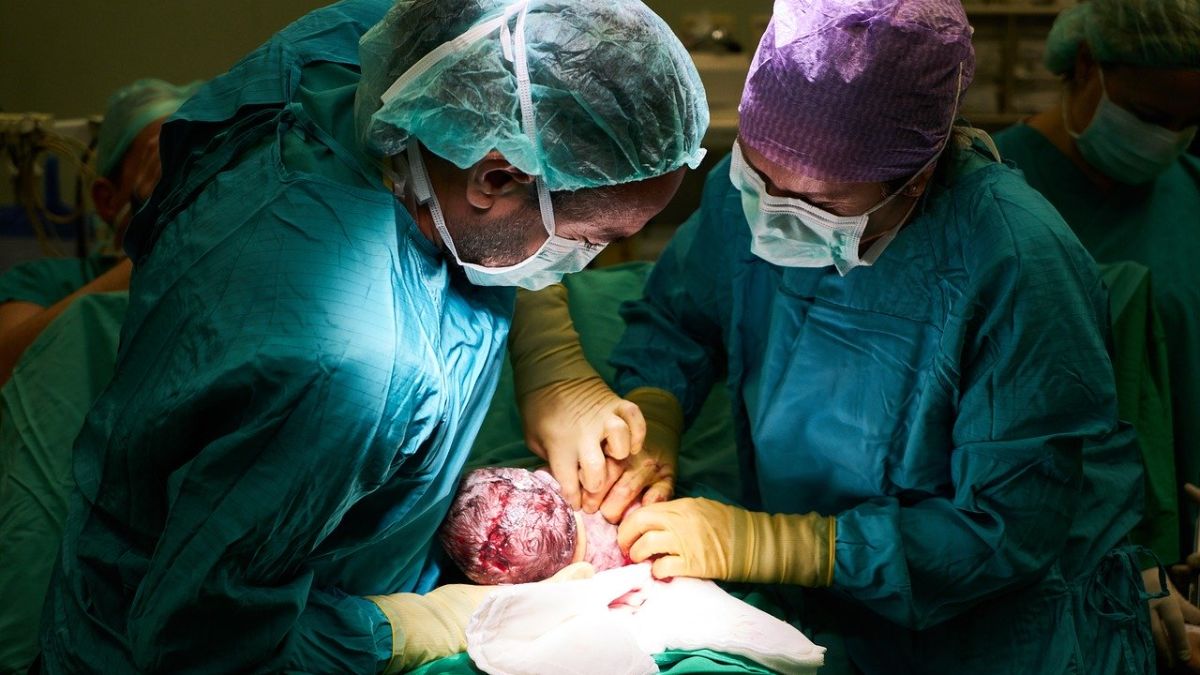
This image contains triggers for: Blood, Procedure, Real Delivery, Surgery
You control trigger warnings in your account settings.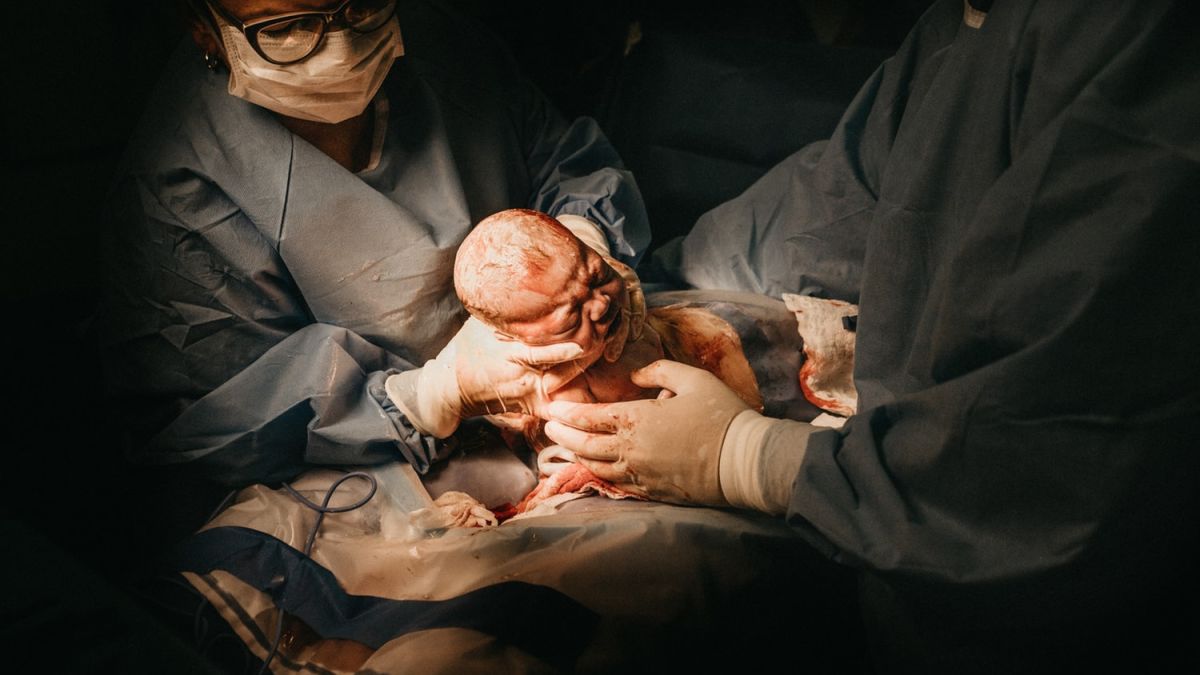
This image contains triggers for: Blood, Procedure, Real Delivery, Surgery
You control trigger warnings in your account settings.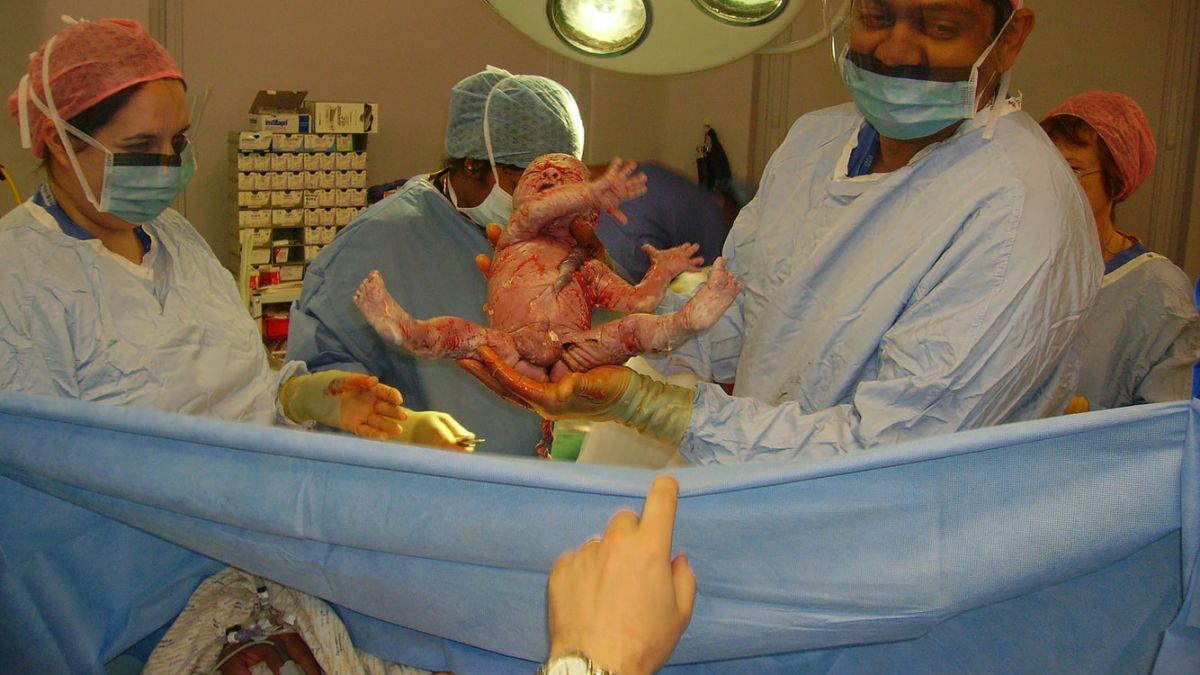
As long as there are no complications, the surgeon will show the baby to the mother quickly, before the baby is taken to be checked over and dried. Occasionally, babies born via c-sections take a minute to breathe and/or cry on their own and may require suction and oxygen. The baby can then be held by the woman or the woman’s partner or other support member.
If general anesthesia is used, the baby can be given to family outside the operating room. If complications arise, the baby will be taken to the neonatal intensive care unit.
Medication (oxytocin/carbetocin) will be given through the woman’s IV to help the uterus contract and expel the placenta, which is removed and examined by the surgeon.
The repair phase of a c-section is usually the longest part and can take up to 45 minutes.
Some surgeons will lift the uterus out of the abdomen to check it thoroughly before doing the repair (called exteriorization of the uterus) and it can be uncomfortable and make a woman nauseous. This method is controversial, and other surgeons will leave the uterus in the abdomen (intraperitoneal repair) for the repair.
The UK’s National Institute for Health and Clinical Excellence (NICE) 2011 Guidelines recommended intraperitoneal repair for this step, as exteriorization of the uterus is associated with more pain and does not improve operative outcomes such as hemorrhage or infection.
Information presented at the American College of Obstetricians and Gynecologist Annual Clinical and Scientific Meeting in 2015 indicated that evidence comparing both techniques was unclear, and that surgeon preference and technical issues such as adhesions are the deciding factors.
Controversy exists over the impact of the single- versus double-layer closure of the uterus on the risk of uterine rupture at the next pregnancy. In their 2011 guidelines, NICE recommended uterine closure in two layers. Their full guidelines on c-section can be read here.
The effects of different suture materials or methods of skin closure at c-section (glue, staples, sutures, followed by a sterile bandage) regarding optimal wound healing are not certain and more trials are recommended.
Immediate Postpartum
Exact procedures will vary between hospitals and obstetricians, but typically, women are moved from the operating room to the recovery room with their baby if there were no complications, and skin-to-skin is encouraged.
If a woman received general anesthesia, family/support can be in the recovery room when she wakes up.
Breastfeeding can start in the recovery area while the mother lies on her side. This can also be done with a bottle, or the partner/support can bottle feed the baby as the woman recovers.
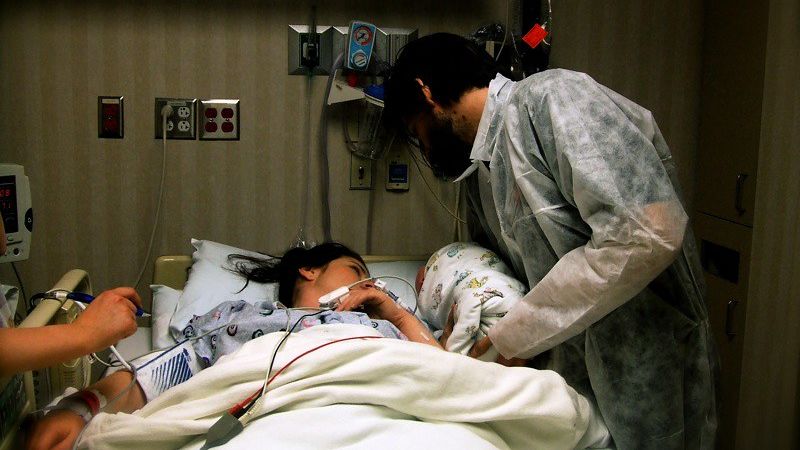
Deep breathing and coughing are encouraged to keep the chest clear. Blood pressure, pulse, temperature, uterine tone, urine output, and bleeding are continually monitored.
After an hour or two in the recovery area (depending on the hospital), women are moved to a postpartum room where they generally remain until they are discharged home.
The average hospital stay for an uncomplicated c-section is three to four days, and earlier discharge is possible for some women.
Pain medicine is available if a woman wishes to have it as the anesthesia wears off (acetaminophen, ibuprofen, codeine, and/or morphine).
Nausea relief options are available for women who may feel nauseous after the procedure. 5‐HT3 antagonists (e.g. ondansetron), dopamine antagonists, corticosteroids, sedatives and acupressure probably or possibly have efficacy in reducing nausea and vomiting symptoms. Women should talk with their health care provider about their options before their procedure, if possible.
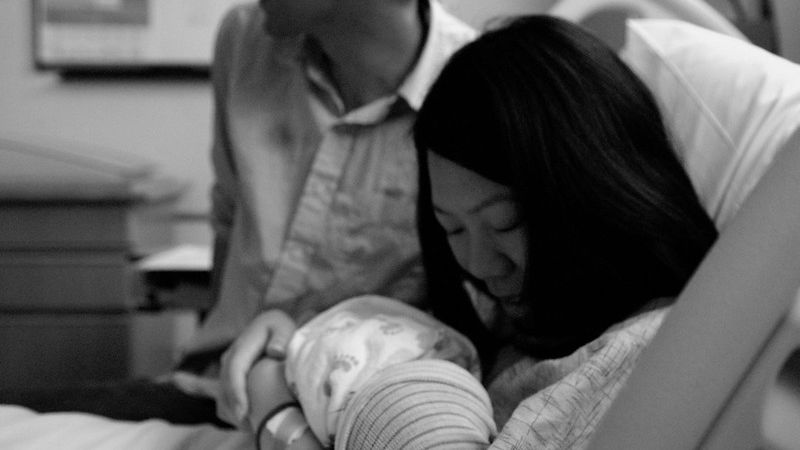
A sanitary pad and disposable mesh underwear are given for bleeding (same as vaginal delivery).
The urinary catheter can be removed following the operation (around 12 to 24 hours) depending on bladder sensation and mobility.
Walking (with assistance) is an important next step, as it lowers the risk of blood clots and helps air move through the intestines to ease gas pain. Showers are also possible with help, and the incision site can be bandaged further to keep it dry.
It is recommended women try sips of water first, followed by light food items. Fizzy drinks, fruit, and heavy meals should be avoided due to potential bloating and pain.
Recovery from a c-section can take several weeks, and women need to follow all instructions given by their HCP.
Vaginal blood loss occurs with a c-section and may last several weeks.
Sex and tampon use should not occur until approved by an HCP due to the risk of infection.
The incision site may be red, irritated, and/or numb, but eventually fades.

Action
Prior to their c-section, woman should be made aware of all risks related to the procedure. Women need to ask their HCP any questions they have regarding the procedure and make sure they understand fully (read Cesarean Section Overview).
After the procedure, women need to follow all postpartum and recovery instructions given by medical personal at the hospital, and their HCP.
Women must contact their HCP if they notice/experience:
The wound is warm/hot to the touch, looks red, or there is a discharge
Heavy vaginal bleeding
Foul-smelling drainage from the vagina
Fever or chills
Severe abdominal pain
Leg pain
Trouble breathing, chest pain, or heart palpitations
Partners/Support
A pregnant woman's partner or another close family member who wishes to be present during the delivery needs to find out what the rules, guidance, and procedures are from the HCP and health care facility, especially during the COVID-19 pandemic, as guidance may change quickly.
Normally, the partner is allowed in the operating room as long as the cesarean section is not an "emergency" cesarean. The partner/family member can still cut the umbilical cord and hold the baby. After the procedure, the partner/family member can be with the woman and newborn in the recovery room.
During postpartum recovery, the woman will need a lot of assistance at first. A cesarean section is major abdominal surgery, and partners should be prepared to take over more responsibility than normal in the first few weeks after delivery as the woman heals.
Resources
Cesarean Birth (American College of Obstetricians and Gynecologists)
Cesarean Section: Information for the Public (Royal College of Obstetricians and Gyneoclogists)
Computerized graphic illustration of cesarean section (very basic) is located here.
For additional education: Institute of Human Anatomy recorded a video regarding the "Anatomy of a C-section". They use human cadavers to teach the general public how a c-section is used, the tissues surgeons cut through, and how the procedure may be performed. This video is for women who want significantly more detail regarding the procedure itself and want to be educated on the procedure and how it relates to abdominal anatomy. Women should use their own discretion. Click here to watch (YouTube).